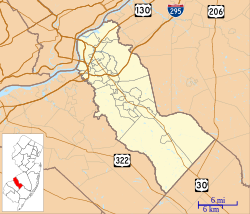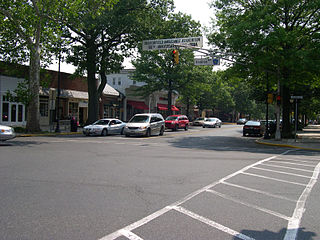
Haddonfield is a borough located in Camden County, in the U.S. state of New Jersey. As of the 2020 United States census, the borough's population was 12,550, an increase of 957 (+8.3%) from the 2010 census count of 11,593, which in turn reflected a decline of 66 (−0.6%) from the 11,659 counted in the 2000 census

Tavistock is a borough in Camden County, in the U.S. state of New Jersey. As of the 2020 United States census, the borough's population was 9, an increase of 4 (+80.0%) from the 2010 census count of 5, which in turn reflected a decline of 19 (−79.2%) from the 24 counted in the 2000 census. As of the 2010 Census it was the smallest municipality by population in New Jersey, with seven fewer residents than nearby Pine Valley, which had 12, while the 2020 census placed Tavistock as second-smallest by population, two more than Walpack Township, New Jersey, which had a population of 7.

The New Jersey Historical Society is a historical society and museum located in Newark, Essex County, New Jersey, United States. The Historical Society is housed in the former headquarters of the Essex Club. It has two floors of exhibition space, a gift shop, and a hall for lectures. The NJHS offers occasional Newark walking tours. The Society formerly published the academic journal, New Jersey History.

The Indian King Tavern was a colonial American tavern in Haddonfield, Camden County, New Jersey, United States, which was the site of a 1777 meeting of the New Jersey Legislature adopted its Great Seal. It was the first State Historic Site, adopted as such in 1903. Its original structure remains largely intact. It is listed on the National Register of Historic Places.

The Moses Merrill Mission, also known as the Oto Mission, was located about eight miles west of Bellevue, Nebraska. It was built and occupied by Moses and Eliza Wilcox Merrill, the first missionaries resident in Nebraska. The first building was part of facilities built in 1835 when the United States Government removed the Otoe about eight miles southwest of Bellevue. Merrill's goal was to convert the local Otoe tribe to Christianity; he had learned the language and translated the Bible and some hymns into Otoe.
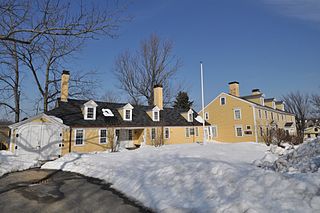
The Ladd-Gilman House, also known as Cincinnati Memorial Hall, is a historic house at 1 Governors Lane in Exeter, New Hampshire, United States. The home was built about 1721 by Nathaniel Ladd as one of the state's first brick houses, and was subsequently clapboarded three decades later. The home was purchased in 1747 by Daniel Gilman, a prominent Exeter merchant. It served as the state treasury during the American Revolutionary War when two members of the Gilman family, Col. Nicholas Gilman and his son John Taylor Gilman, later the state's governor, served as treasurers of the state. Also born in the house was Founding Father Nicholas Gilman, Jr., a signer of the United States Constitution and U.S. senator from New Hampshire.
Tualatin Academy was a secondary school in the U.S. state of Oregon that eventually became Pacific University. Tualatin Academy also refers to the National Register of Historic Places-listed college building constructed in 1850 to house the academy, also known as Old College Hall. The building now serves as the Pacific University Museum, and is one of the oldest collegiate buildings in the western United States.

Liberty Hall, also known as the Governor William Livingston House, located on Morris Avenue in Union, Union County, New Jersey, United States, is a historic home where many leading influential people lived. It was documented by the Historic American Buildings Survey (HABS) in 1938. The house was added to the National Register of Historic Places as a National Historic Landmark on November 28, 1972, for its significance in politics and government. It is now the Liberty Hall Museum.

The dogtrot, also known as a breezeway house, dog-run, or possum-trot, is a style of house that was common throughout the Southeastern United States during the 19th and early 20th centuries. Some theories place its origins in the southern Appalachian Mountains. Some scholars believe the style developed in the post-Revolution frontiers of Kentucky and Tennessee. Others note its presence in the South Carolina Lowcountry from an early period. The main style point was a large breezeway through the center of the house to cool occupants in the hot southern climate.

Glendale Methodist Episcopal Church is a historic church at 615 Haddonfield-Berlin Road, at the junction with White Horse Road, in the Glendale section of Voorhees Township, Camden County, New Jersey, United States. It was added to the National Register of Historic Places on August 4, 1995 for its significance in community planning, development, and education from 1855 to 1920. At the time of its construction, the village of Glendale was impacted by the train station stop of Ashland on the Camden Atlantic Railroad. Because of the railroad, Philadelphians and shore villagers came to trade and do business.
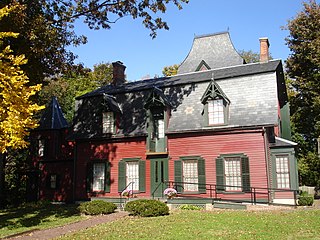
The Nathaniel Drake House is located at 602 West Front Street in the city of Plainfield in Union County, New Jersey. The house was built in 1746 and was added to the National Register of Historic Places on June 19, 1973, for its significance in architecture. It now operated as the Drake House Museum and is the headquarters of the Historical Society of Plainfield, though the building is owned by the City of Plainfield. The most famous piece in the Society's collection is the painting, "The Death of General Sedgwick" by Julian Scott.

Pomona Hall is a colonial mansion located at 1900 Park Boulevard and Euclid Avenue, in Camden, Camden County, New Jersey, United States, that operates as a museum by the Camden County Historical Society. The first building on the site was constructed in 1718, while construction of the more substantial mansion house was started in 1726, with later additions made in 1788. It is not known when the house was first called Pomona Hall; but it is marked on Hill's Map of Philadelphia and Environs, published in 1809.

Haddon Fortnightly Club House is located in Haddonfield, Camden County, New Jersey, United States. The building was built in 1857 and added to the National Register of Historic Places on October 26, 1972.
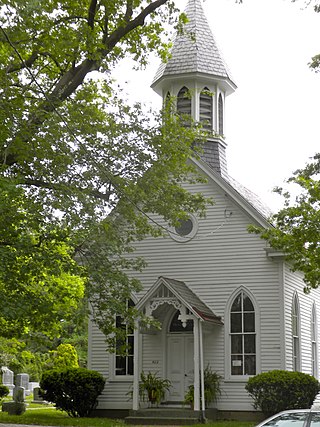
Haddonfield Historic District is located in Haddonfield, Camden County, New Jersey, United States. The district was added to the National Register of Historic Places on July 21, 1982.

Burrough-Dover House is located in Pennsauken, Camden County, New Jersey, United States. The house was built in 1710 and added to the National Register of Historic Places on October 25, 1973. Restoration work on the house has been performed by the Pennsauken Historical Society.
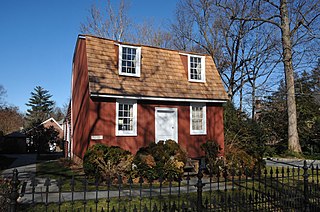
Samuel Mickle House, also known as the Hip Roof House, is located in Haddonfield, Camden County, New Jersey, United States. The house was built in 1736 and was added to the National Register of Historic Places on May 21, 1975.
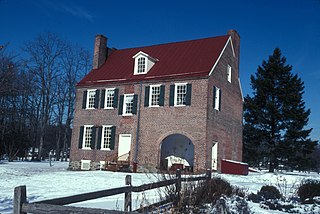
Barclay Farm House, also known as Barclay Farmstead, is located in Cherry Hill, Camden County, in the U.S. state of New Jersey. The house was added to the National Register of Historic Places on January 26, 1978.

The United States lightship Barnegat (LV-79/WAL-506), is located in Camden, Camden County, New Jersey, United States. The lightship was built in 1904 and was added to the National Register of Historic Places on 29 November 1979.

The 1803 House, also known as the Jacob Ehrenhardt Jr. House, is a historic home located in Emmaus, Pennsylvania. It was built in 1803 for Jacob Ehrenhardt Jr., a son of one of the town's founders.

Captain Samuel Van Leer was a military officer from Pennsylvania who served as a captain in the Continental Army during the American Revolutionary War and as lieutenant in the Chester County Light Horse Volunteers from 1781 to 1785. After his retirement from the military, he owned the Reading Furnace ironworks.

